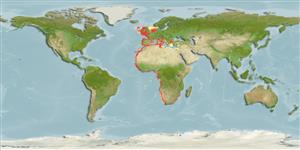Elasmobranchii (sharks and rays) >
Carcharhiniformes (Ground sharks) >
Triakidae (Houndsharks) > Triakinae
Etymology: Mustelus: Latin, mustela, -ae = weasel (Ref. 45335).
Environment / Climate / Range
Ecology
Marine; demersal; depth range 5 - 624 m (Ref. 56504), usually 5 - 50 m (Ref. 244). Temperate, preferred 26°C (Ref. 107945); 58°N - 34°S, 19°W - 36°E
Eastern Atlantic: UK to the Mediterranean, Morocco and Canary Islands; possibly Azores, Madeira, Angola to South Africa; including Indian Ocean coast. Often referred to as Mustelus canis which is restricted to the western Atlantic.
Length at first maturity / Size / Weight / Age
Maturity: Lm ?, range 80 - ? cm
Max length : 200 cm TL male/unsexed; (Ref. 27000); common length : 100.0 cm TL male/unsexed; (Ref. 26999); max. reported age: 24 years (Ref. 30745)
Found on the continental shelves and uppermost slopes, from the intertidal region to at least 350 m depth (Ref. 244). Collected to depth of 624 m in the eastern Ionian Sea (Ref. 56504). Sometimes in midwater but prefers to swim near the bottom (Ref. 244). Feeds mainly on crustaceans, but also cephalopods and bony fishes (Ref. 244). Viviparous, with a yolk-sac placenta (Ref. 244). Taken by shore and ski-boat anglers (Ref. 5578). Utilized for human consumption, oil, and fishmeal (Ref. 244). Sexual maturity is reached at a length of 70-80 cm (Ref. 35388).
Viviparous, with a yolk-sac placenta; 4 to 17 (Ref. 39938) young in a litter. Size at birth about 39 cm. Distinct pairing with embrace (Ref. 205).
Compagno, L.J.V., 1984. FAO Species Catalogue. Vol. 4. Sharks of the world. An annotated and illustrated catalogue of shark species known to date. Part 2 - Carcharhiniformes. FAO Fish. Synop. 125(4/2):251-655. Rome: FAO. (Ref. 244)
IUCN Red List Status (Ref. 115185)
CITES (Ref. 94142)
Not Evaluated
Threat to humans
Harmless
Human uses
Fisheries: highly commercial; gamefish: yes
More information
ReferencesAquacultureAquaculture profileStrainsGeneticsAllele frequenciesHeritabilityDiseasesProcessingMass conversion
Tools
Special reports
Download XML
Internet sources
